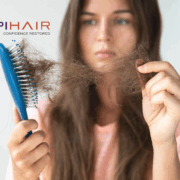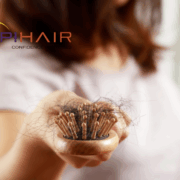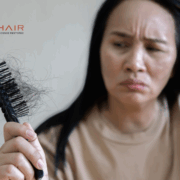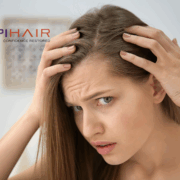Typical Hair Loss In Women in Franklin, TN
Boost your confidence with effective hair loss treatment options for women.
Hair loss is a common concern for many women, and it can be a distressing experience that impacts self-esteem and confidence. While hair loss is often associated with men, it is important to recognize that women also experience this issue. Understanding the causes and treatment options for hair loss in women is crucial for anyone seeking to address this condition and regain healthy, beautiful hair.
Hair Growth and Loss
Appreciating the natural hair growth cycle is essential in comprehending hair loss. The hair growth cycle consists of three phases: anagen (growth phase), catagen (transitional phase), and telogen (resting phase). Each hair follicle operates independently, and various factors can influence the duration and quality of each phase.
Diagnostics to detect the cause of hair loss in women can include a scalp biopsy, blood tests, and microscopic analysis of a hair strand. It is important to consult a medical professional to accurately diagnose the underlying cause of the hair loss and determine the most appropriate treatment options.
Common Causes of Hair Loss in Women
Hormonal Changes
Hormonal changes, such as those experienced during pregnancy, childbirth, menopause, or thyroid imbalances, can lead to hair loss. These changes can disrupt the natural hair growth cycle, leading to increased shedding or thinning of the hair.
Medical Conditions
Certain medical conditions, such as alopecia areata, autoimmune disorders, and underlying health issues, can contribute to hair loss in women. It is crucial to address any underlying medical conditions to effectively manage hair loss.
Stress and Lifestyle Factors
Chronic stress, poor nutrition, and unhealthy lifestyle habits can negatively impact hair health. Maintaining a balanced diet, managing stress, and prioritizing healthy lifestyle choices can significantly influence hair growth and prevent excessive shedding.
Genetic Predisposition
Genetic predisposition can play a significant role in hair loss for both men and women. Understanding family history and genetic influences can provide valuable insights into potential hair loss patterns.
Treatment Options for Hair Loss in Women
Topical Treatments
Topical treatments, such as minoxidil, can help stimulate hair growth and slow down the progression of hair loss. These treatments are often applied directly to the scalp and can be effective for certain types of hair loss.
Prescription Medications
For hormonal-related hair loss, prescription medications like spironolactone or oral contraceptives may be recommended to address the underlying hormonal imbalances contributing to hair loss.
Platelet-Rich Plasma (PRP) Therapy
PRP therapy involves extracting a patient’s blood, processing it to isolate the platelet-rich plasma, and injecting it into the scalp to stimulate hair follicles and promote hair growth.
Low-Level Laser Therapy (LLLT)
LLLT utilizes red light to stimulate hair follicles and promote hair growth. This non-invasive treatment option has gained popularity for its ability to improve hair thickness and density.
Last ideas
Overall, hair loss in women can be a complex and multifaceted issue with various underlying causes. nderstanding the factors contributing to hair loss and exploring the available treatment options, women can take proactive steps to address this condition and restore healthy, vibrant hair.














